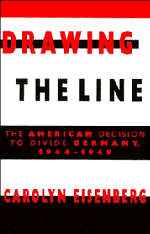Book contents
- Frontmatter
- Contents
- Preface and Acknowledgments
- Germany – Occupation Zones, 1945
- Introduction: Private Polowsky's Oath
- 1 Plans
- 2 Making Peace
- 3 The Limits of Reform: The U.S. Zone
- 4 A Fragile Friendship
- 5 The Russian Challenge
- 6 Bizonal Beginnings
- 7 The Doctors Deliberate
- 8 Marshall's Medicine
- 9 A Separate State
- 10 Cold War Germany
- 11 Winning
- Conclusion: The American Decision to Divide Germany
- Bibliography
- Index
6 - Bizonal Beginnings
Published online by Cambridge University Press: 07 October 2009
- Frontmatter
- Contents
- Preface and Acknowledgments
- Germany – Occupation Zones, 1945
- Introduction: Private Polowsky's Oath
- 1 Plans
- 2 Making Peace
- 3 The Limits of Reform: The U.S. Zone
- 4 A Fragile Friendship
- 5 The Russian Challenge
- 6 Bizonal Beginnings
- 7 The Doctors Deliberate
- 8 Marshall's Medicine
- 9 A Separate State
- 10 Cold War Germany
- 11 Winning
- Conclusion: The American Decision to Divide Germany
- Bibliography
- Index
Summary
We have much at stake in gaining the opportunity to fight for democratic ideals in Eastern Germany and in Eastern Europe. This opportunity would result from the true unification of Germany under quadripartite control.
(Lucius Clay to Byrnes, November 1946).But if agreement with the Russians involves any sacrifices in the economic field which would have the effect of delaying or impeding the rapid improvement of living standards and restoration of confidence in our zone of occupation, then such an agreement in my opinion, will prove to be a hollow one, and we will find that we have purchased unreality with reality.
(George Kennan to Byrnes, November 19, 1946).In july 1946 the Soviets adopted a definite policy. When the Paris Conference of Foreign Ministers reconvened, Molotov astonished his colleagues by calling for the formation of a centralized German government and the upward revision of the German Level of Industry, to be accompanied by the payment of reparations from current production. Rather than stimulating a new round of Allied negotiations on German unification, the Soviet shift accelerated the movement toward a merger of the American and British zones.
On the American side, there were diverse motives for establishing the bizone. There was universal dislike of British economic policy and a desire for a more direct voice in the Ruhr. Within U.S. Military Government this was joined to the expectation that, carefully handled, economic fusion could establish a framework for four-power amalgamation. Among many State Department officials, it was viewed in opposite fashion: as the first step in a deliberate strategy of dividing the country.
- Type
- Chapter
- Information
- Drawing the LineThe American Decision to Divide Germany, 1944–1949, pp. 233 - 276Publisher: Cambridge University PressPrint publication year: 1996



